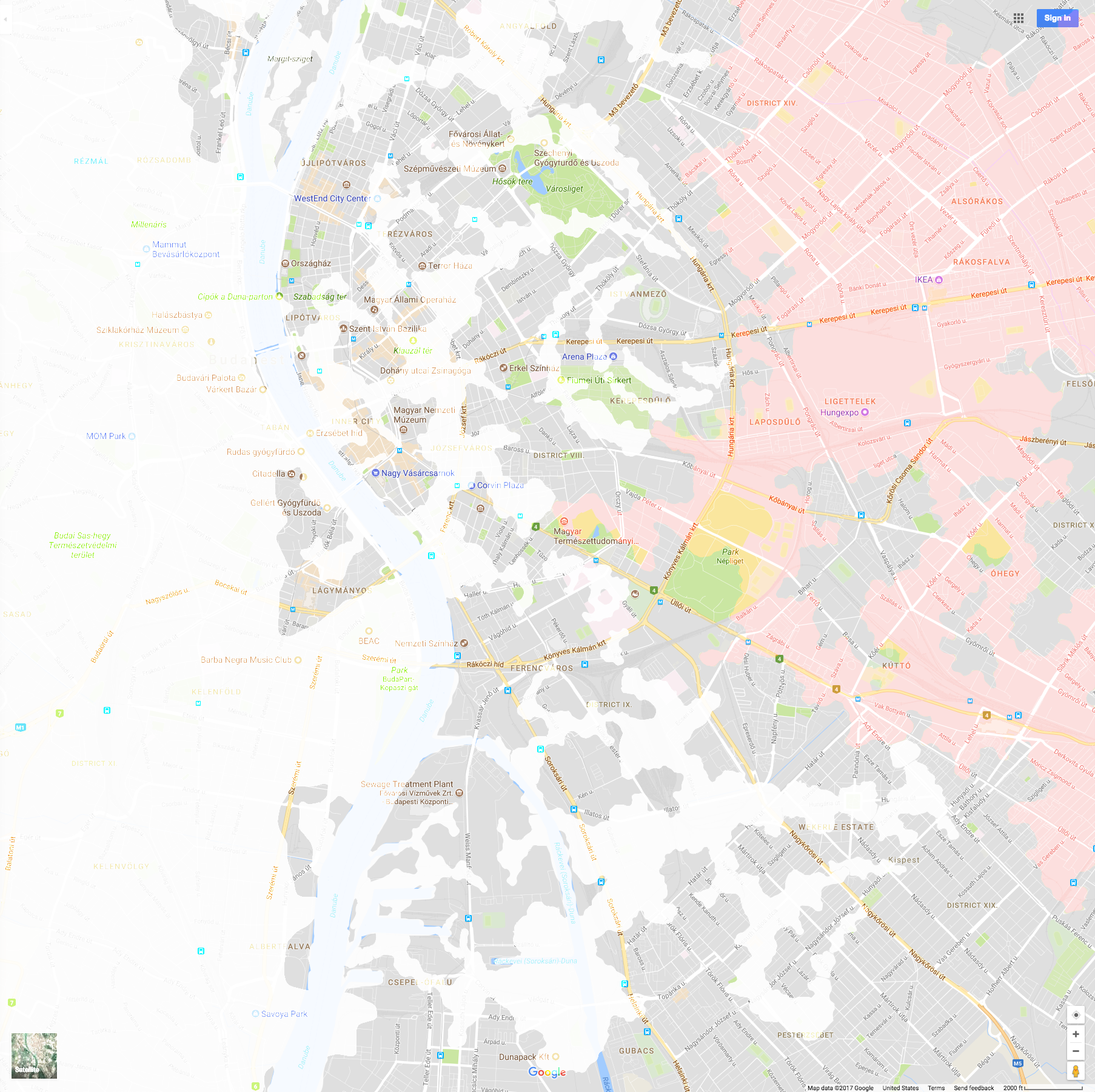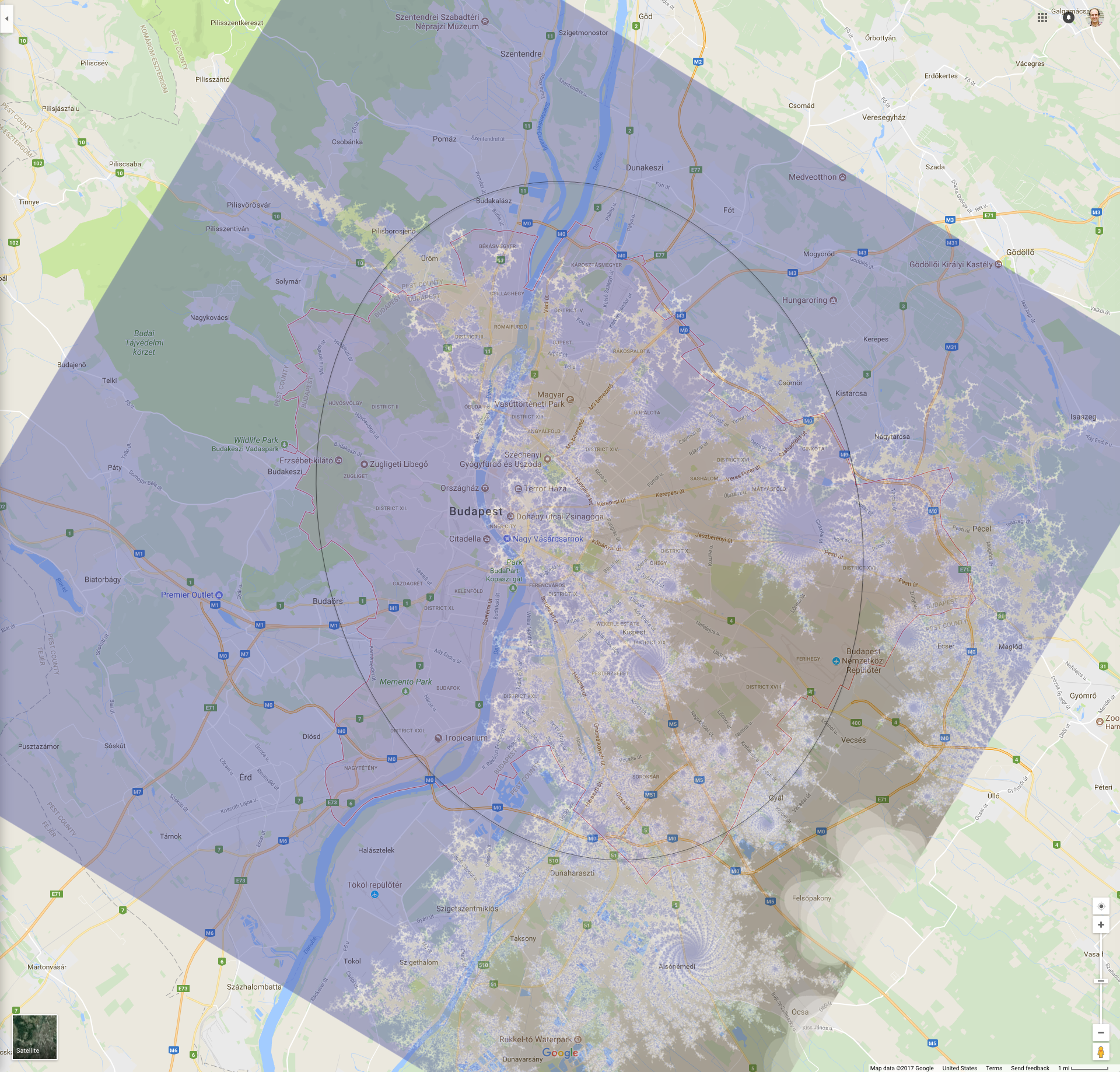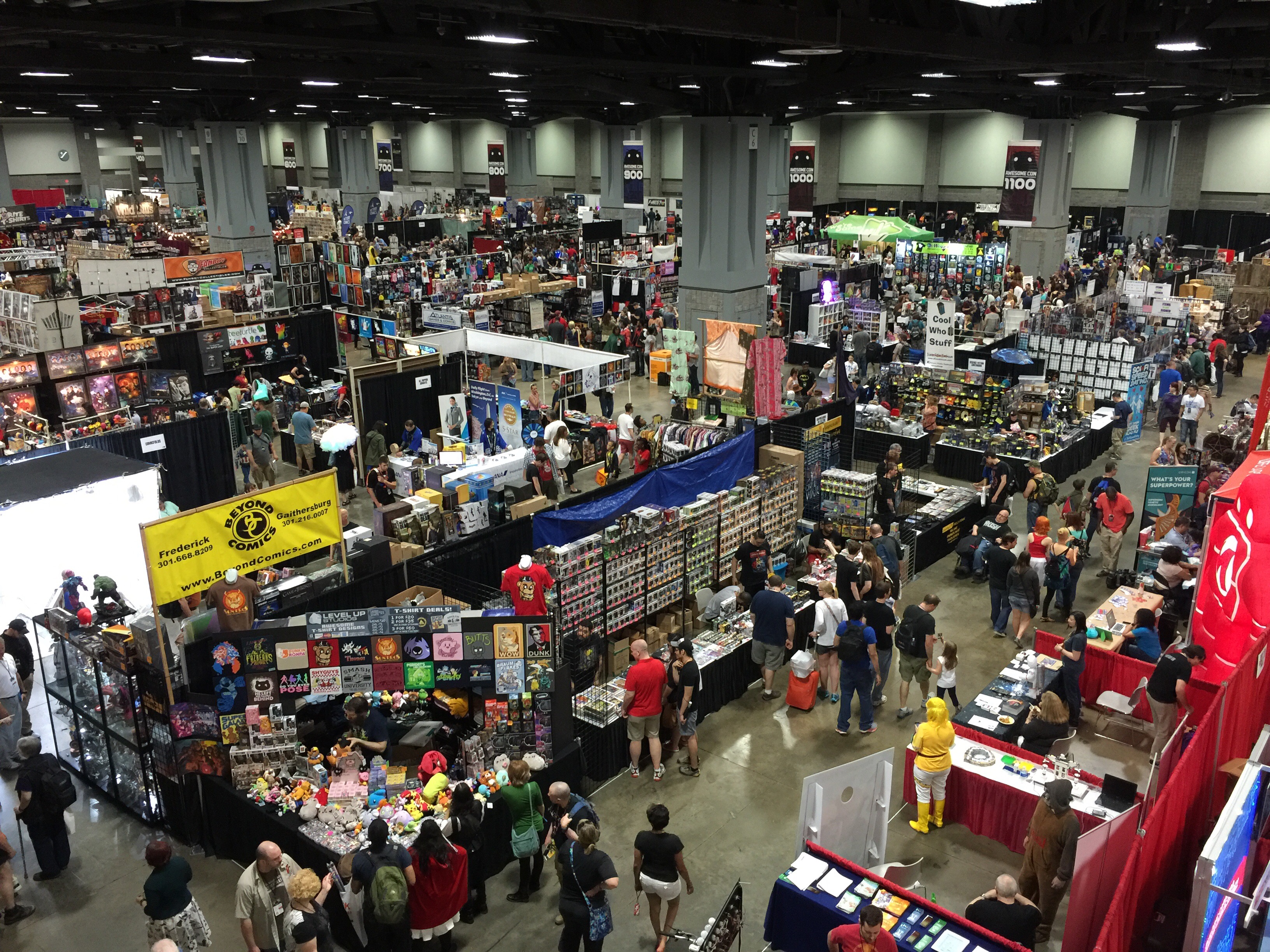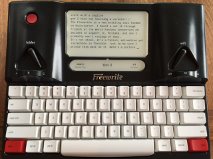My science-fiction work-in-progress is set in a single city, and I needed to see it to imagine living in it. Welcome to Pest! Only walk on gray parts….

Budapest was a proxy in the One-Day War between Greater Russia and Umoja East Africa. Buda is now the White Lake, a boiling toxic waste of microscopic robots that eat carbon dioxide, and anything else, to make diamonds that wash on its shores. Both embargoed no-person’s-land and boomtown, Pest houses thieves, smugglers, engineers, and skaters, daredevil gladiators who jump and spin over the Lake in maglev boots, just one fall from death.
I suppose I could have done any old thing to ruin a city, but I wanted a dusting of Science! in my fiction. I thought a fractal would make a believably consistent result small enough for microscopic robots to store. I used FractalWorks, a Mac app, to generate a tiny portion of the celebrated Mandelbrot function, and overlaid this on a large screenshot of central Budapest, so its finer arcs and whorls were the length of city blocks.

I didn’t think at the scale of blocks it could ever be so precise – if nothing else, land would collapse – so I cut out the Lake using an image editor’s predictive selection tool, to make the edges sloppy and eroded.
Both the pink and white areas are products of the fractal. The white is the Lake itself, while the pink represents Soft Lands, areas of shifting underground streams through which nanites recharge, around which smugglers tunnel.
It’s been a huge help to have the reference. Putting my characters on a literal map lets me figure out relative distances, and helps me imagine the land and the city that might grow from it.
I also thought further about my mechanical monster’s makeup. Where Lake meets land has always been seductively quiet, since earliest drafts. Instead, let the meeting of Lake and Soft Lands be a place of churn and upheaval, the turbulence of nanites going into and out of dormancy around the buzz of other nanites quantumly-uncertain just where their strange fractal stops. I have a heart murmur too.
It’s easier to name things in the context of the city’s weird sense of humor now, and I’m looking at it as more impressively built than previous drafts. Where before it was falling apart and hastily erected, now I see it as printed and reprinted, strange but regular, by the same artificially-intelligent drone “taxibots” that run the city services. This has new virtues and a very different look. And some rewriting.
If this map gets reproduced in the book, I don’t want the plain line drawing quality of most novel maps. Rather I’d commission a graphic artist to generate a cityscape, degrade that so it looked like a 12th-generation-photocopy of an old image, have all the landmarks written in sloppy marker. At top: “Welcome to Pest where you will likely die.” At bottom: “Wanna know more? Live and learn.”
Tag: write
-
Destroying Budapest
Budapest map and Mandelbrot sliver -
Make time for new work
My main creative work since my book contract has either been editing my manuscript or developing my (approach to) social media. By any commercial measure, that’s what I should have done. Polishing and sharing best honors my creative expression.
One has creative intention too, and each success makes one’s ground more fertile. Recently my editor Vivian Caethe, fresh off her first Kickstarter success, turned a Tumblr post into a new anthology on Kickstarter, which shows how quickly ideas can bloom.
I need to be there for my finished work. I also need new work to do.
These last two weeks I’ve been making myself make things up, just opening blank text screens and letting words fly. It’s not exactly automatic writing but it’s my least self-judgmental form of creativity. Nothing that will go further in this form. Nothing anyone’s waiting for yet. It can be stupid and playful. I even wrote the outline of a wordless ten-minute play, mostly on my smartphone, in a car.
Most of these ideas will go nowhere. A few return in funny ways. A jokey conceit I never developed for my blog became a Russian propaganda television serial in my NaNoWriMo manuscript. That manuscript was once a dream, hastily written down and played with for weeks thereafter. In another year it could be a book.
It’s important to make new things, especially if it feels unimportant. Something takes root if you keep seeding. -
Books at AwesomeCon need flair
AwesomeCon‘s sales and promotional floor is so big that guides and maps never refer to it as a unit bound by walls, only to its subsections. All of it is dense with visual stimulus and novelty. Vendors sell comics, books, movies, posters, toys, models, clothing and accessories, even niche products like leather bondage wear or rings that serve as dice for gaming. Cosplay abounds, and well done.

Stand out here!
Still, you can find the printed word. A handsome cover is an attractor here. One printer sells new restyled editions of public-domain classics. Sellers have curiosities like high-end reprints or special editions of the most popular books of our day. And there are presses and solo creators.
I don’t have a lot of fine-grain insight. I saw signings, drawings, gimmicks aplenty. Whatever else, one has to look like one gives a damn and like others do too; like this is a privilege, a summit, not the end of a long and dreary line.
Soho Press has a well-dressed urbane young marketer standing between a simple logo backdrop and a skirted table of original novels. She cheerfully tells me that she’s here to support an author on a panel, but it’s a good chance to market other titles, including a new YA. She hints it was a new effort for them to come this far south.
The booth is in a side alley, without much natural crowd flow, but the display catches enough attention that she sells books while telling me about how releases get marketed. When I buy two books, she tells me one comes with a poster. She unrolls it. It’s far cartoonier than the novel’s bold graphic cover. I kindly decline.
“I’m not surprised,” she tells me. There’s a savvy in the remark that seems of a piece with the product line. A marketing meditation: how deep can brand and identity go?
Soon after, I walk past an independent writer on a busier alley. She has no backdrop, no table-skirt, just short stacks of books on naked fake-woodgrain tabletop. It looks like it’s being set up.
She calls out, seeing my glance. “Do you read books?” she asks plaintively, as if her greater hopes for connection have been dashed.
Little more to see on a closer look. She has printed glossy promotional bookmarks for each book, but no display. No description other than the cover text. It is not enough. I feel like I have to infer everything. She asks me tentative questions as if to find a hook that will attach her book to me.
Once it is clear I am less audience than sympathetic peer, we chat. She tells me of other venues where she sells books, of how a venue this size is still too much for her child. She is connected through fandom to a star of a vampire television show. Behind a bowl of candies, a framed page of small text describes donations to the star’s non-profit foundation.
I wonder how she got the idea to come to AwesomeCon. Perhaps she thought her show and star would connect her. Perhaps the size impressed her. It feels like a Hail Mary. It can’t be a cheap rental but she has failed in her research and come unprepared.
It is harsh to compare an individual to a small press, but they both took similar space in an enormous con. It does no good to be ignored by tens of thousands of people. -
Writer vs author (social media)
This is a post about web marketing and how I am working through mine. TL;DR – avoid mistaking writer for author, mistaking content for news. (more…)
-
Twenty lousy minutes on the Freewrite (review)
Less tool than fetish, and disappointing.
Funded on Kickstarter, the new Freewrite is a solid, lovingly-crafted device that promises to return writers to a place of distraction-free spontaneity. From its low-power e-ink screen to the aluminum case – with handle – to the deep-traveling satisfyingly-clicky Cherry keys, the Freewrite consciously recalls early computers, manual typewriters, and a more physical, engaged time. I love touching it. Really.

Alas, none of those keys moves the cursor.
“Distraction-free” writing is not a method like touch-typing, but an ideal. For some, it means paper. For others (like me), it means starting my work in a text editor, not a print-oriented word processor like Word or OpenOffice. For still others, it means gimmicky apps that literally delete your writing if you pause too long. Whatever works, right? And if it doesn’t work, you can do something else.
Not on the Freewrite. For the Freewrite, “distraction-free” means, and only means, a weirdly oppressive no-turning-back mentality, like Allen Ginsberg’s “first thought best thought” warped from liberating ideal into blind diktat without recourse.
You can only keep keying. You can’t go backwards, save to delete – and that has the acceleration of a Tesla, one word, two words, a paragraph whoa! You can’t go up three lines and add a header. You must go forward, only forward, like Orpheus leaving Hades.
I don’t even write that way on paper.
The Freewrite also requires a better computer to finish one’s work. Just getting text out of it – set up a special account, to either e-mail the work as an non-editable PDF, or to push it into Dropbox folders as Word .docx files – is a ridiculous kluge, a giant chicken-wire afterthought that makes the whole Freewrite process feel like something out of the movie Brazil. (more…) -
Merge and purge (writing and language)
My first draft was 220,000 words of symbol-laden passages and over-described locales. Over years I steadily replaced sets of words with smaller stronger ones, refining the language to heighten the story and the emotional viewpoint. The never-quite-articulated goal was for the words to hold more weight relative to their size thanks to their structure.
In four passes I got down to 120,000 words. I cut few complete scenes. Mostly I just kept redoing the language, finding slenderer shorter beams for each bit of structure, abandoning ideas that were less essential. It was like starting with an Art Deco skyscraper and renovating it into a geodesic dome, bit by bit.
Now I hope to write less in the first place but I am not sure it is turning out that way. At least I outline more, or more frequently, nothing grand but enough to guide me. Still, once it’s prose, my process scales to it. Less is an asymptote. Even a small post like this, I write and rewrite, in layers, questioning the questioning.
Yesterday going through the magazine pile for something to read with my soup, I stumbled upon an article discussing linguist Noam Chomsky’s controversial recent ideas about the beginning of language. Chomsky theorizes early humans created the foundations of language by developing a new ability Chomsky calls Merge, the ability to group mental objects and work with them as a unit.
I’m no judge of linguistics theory but as an idea Merge resonates with me. Something in my process also looks to merge, or at least more densely encode, meanings – and wants a lot of meaning to encode. Just as we care about both increasing bandwidth and compressing data, maybe the drive to merge is tied in with communication in multiple ways, a circle of acquiring and optimizing we have yet to map out.
I also confess a happy feeling about my own fiction’s truth. One of the angels to appear late in my novel is of_clumping, which I felt was a driving force in our universe, from stars to black holes. How nice to think this is an angel of meaning as well.
-
Big news – and some thanks
I am thrilled to announce I have signed a contract with WordFire Press to publish The Demon in Business Class, my first novel!
I am so excited about this! But it’s some months away, with a lot to do between now and then. I’ll talk about it much more as the book launch approaches, and I hope you can be part of it.
I’d like to thank Kevin J. Anderson, Vivian Trask and WordFire Press for the warm welcome and the hard work ahead.
This novel is years in the making, and I have pages of thanks. I here want to acknowledge the people who worked on this most recent stage, with the final draft manuscript and the marketing plan. Thanks to Jackie Dobranski, Kate Yonkers, Jessica Epperson-Lusty, Laila Sultan, Joshua Essoe, Jennifer Brinn, Melissa Cox, and Adrian Bryant for their invaluable help and feedback.
Thanks also to Wayland Smith for inspiring me to up my professional game.
I have written a beautiful book, of its time, for times ahead. I want to share it with you and the world. I’m pleased to have an excellent publisher to help me do that. -
NaNoWriMo recap (winner!)
National Novel Writing Month was a huge personal success for me, and a big confidence booster. I will miss my silicone NaNoWriMo bracelet tomorrow.
By the numbers, 50,028 words, finished in the wee hours of November 27. On the twenty-three days I wrote, I averaged 2,175 words a day, due mainly to a big push in the first two weeks that had me writing close to 2,500 a day.
As a project, I reached the end of the draft narrative. I kept control of the pacing so I landed it roughly as I intended. It was an active effort, matching my word count to the outlines, planning scenes ahead in 500-word increments, fleshing out passages still short of their part of the total.
However measured, when I could write, I did, at speed and with some level of consistent craft throughout. I’m not sure I believed I could do it. I am glad to no longer have to rely on belief.
I don’t think I have universal advice, but for me it started well before November 1. (more…) -
Making a busy life into a busy blog
The blog has been stale although I have been busy.
In posts across the web, that “although” is a “because” — you know you’ve read it, here and a thousand other blogs. Which is a problem. It’s one thing to know silent business is a missed opportunity to self-promote, another to make it an aspect of writing and not an intrusion. With Jeff VanderMeer’s Booklife, I am learning how to change that.
I am late to Jeff VanderMeer’s excellent fiction, but when the esteemed Paulo Bacigalupi mentioned VanderMeer’s Southern Reach trilogy (Annihilation, Authority, & Acceptance) on three separate panels at CapClave, I took it for advice — and I loved Annihilation. (The others wait for Xmastime.)
But, in the dealer’s room at World Fantasy Convention, after VanderMeer signed my copy of Annihilation, I passed a table that had his book Booklife. Just the title made my heart both sink and rise. A booklife? What’s that? I want one. I really do. (more…) -
The pre-apocalypse
My writing group noted that my new story, though a different setting, is also a post-apolcyalypse tale, or at least post-disaster. One colleague included my novel in that theme, even though in my novel things are good, but about to get worse. It’s pre-apocalyptic, she said.
Something in that. My faith is that humanity will persist, but a lot of bad things are going to happen. By the standards of the past they already have. Like my mentor Philip K Dick, I’m less pinpointing details of the great shift, just exploring scenes after upheaval, where people have adapted to far different norms of environment and behavior. I no doubt absorbed this from my family history, for my parents fled war and Soviet occupation, and my own late 20th century life, where we took on huge social changes, and where the rest of the world changed vastly more. I greatly admire writers like Jim Shepard and Harlan Ellison, who change up place and time each story yet keep consistent in their approach and style.
Perhaps I’ll be more sensitive to this strain of pre-apocalyptic. I hope it will give me a way to glide across genre. I would enjoy writing historical. (more…)